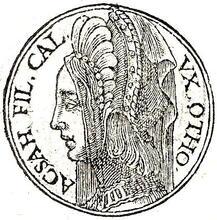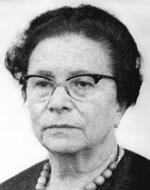Women with Hand-Drums, Dancing: Bible
According to several biblical passages, women in ancient Israel—beginning with Miriam after the crossing of the Sea of Reeds—celebrated military victory by singing, dancing, and drumming. An array of archaeological materials and texts from other ancient Near Eastern cultures indicates that the drum was a woman’s instrument. This means that women in ancient Israel were the drummers in the musical ensembles, which played in the secular and religious contexts mentioned in the Bible. Moreover, their dances were circle dances rather than the leaping dances associated with men. As participants in the performance ensemble of drum-dance-song, they had the empowering experience of working together and carrying out a socio-religious function.
Biblical Texts Mentioning Women Celebrating Victory
After the Israelites escape from Egypt and from the Pharaoh’s army at the Sea of Reeds (NRSV, “Red Sea”), the prophet Miriam leads a celebration. Accompanied by “all the women,” who are dancing and playing hand-drums (Exod 15:20–21), she sings of YHWH’s victory. Most English translations, including the NRSV, use the word tambourines in this passage. That word, however, is anachronistic, for there is no evidence that tambourines were invented until the Roman period at the earliest, and perhaps not for several centuries later. The Hebrew word tof represents a hand-held frame-drum, a hoop-shaped drum with a diameter wider than its depth and well known as a popular membranophone (percussion instrument) from artistic representations preserved from the ancient Near East.
The scene of Miriam with her chorus of women drummers and dancers is echoed in several other instances in which song, dance, and drums appear in connection with women musicians. After a victory over the Philistines, David is welcomed by women singing, dancing, and playing frame-drums (1 Sam 18:6–7). Two other passages probably present, elliptically, a similar situation: Deborah sings out after YHWH brings victory for the Israelites over the Canaanites in Galilee (Judg 5:1), and Jephthah’s daughter welcomes her father with dancing and drumming after his God-granted defeat of the Ammonites (Judg 11:34). The elements of drum, dance, and song constitute a women’s performance genre: the musical celebration of military victory. Another elliptical passage, 2 Sam 1:20, claims that Philistine women would perform a victory song if they heard the news that Saul and Jonathan had died. The celebratory nature of the genre is extended, in prophetic eschatology, to the rejoicing that accompanies God’s restoration of Israel (Jer 31:4, 13).
The Frame-drum as a Woman’s Instrument
The 2 Sam 1:20 passage, which refers to Philistines, suggests that this performance genre was part of the general culture of the eastern Mediterranean in biblical times. Archaeological evidence supports that possibility. Egyptian wall paintings, scenes on metal and ivory vessels from Cyprus and Phoenicia as well as Mesopotamia, and most notably small terra-cotta figurines from many Near Eastern sites all depict musicians playing a significant repertoire of musical instruments. Musicologists have assigned them to various categories: wind instruments, stringed instruments, instruments that are self-striking (such as cymbals), and percussion instruments. In virtually every instance, the frame-drum players are female. This evidence, along with cross-cultural materials as well as a reference to the Canaanite goddess Anath with a hand-drum, suggests that the playing of these percussion instruments was a specifically female role in the ancient Mediterranean world.
The identification of the frame-drum as a woman’s instrument has implications for the understanding of several biblical texts mentioning musical performance. The Bible mentions dozens of musical instruments of the various types; but only one percussion instrument is named—the tof, or hand-drum—even though other kinds of drum were known elsewhere in the biblical world. Whenever this word is found, it is quite likely that the presence of female instrumentalists is implied. This is particularly true in a series of psalms that depict cultic processions and celebrations in praise of YHWH. In Ps 68:25, a procession into the temple involves singers, female hand-drummers, and other musicians. The word for drum players is unambiguously feminine. The words for the singers and musicians are masculine, but they may include females and males, given the nature of Hebrew as a gendered language with masculine nouns often used for both genders. The references to musical ensembles in several other psalms (Pss 81:2; 149:3; 150:4) can be interpreted, because they include the hand-drum, as including female instrumentalists in cultic musical performance.
Women’s Dances
Not only was the drum a woman’s instrument, but also the style of dancing associated with women differed from that of men. The Hebrew word for “dances” in the texts mentioned above is meholot, which denotes a circle dance. In contrast, the root (rkd), which probably means leaping up and down in dance, is used in contexts where men are dancing, as when King David brings the ark of God up to Jerusalem (1 Chr 15:29).
Women’s Performance in Ancient Israel
Clearly the frequent claim that women did not take part in public religious occasions in ancient Israel needs to be contested in light of readings that take extrabiblical artifactual evidence into account. In addition, recognizing the existence of women’s performance traditions allows us to acknowledge that women had the benefit of participating together in professional associations. Gathering to rehearse, compose, and perform provided women with the opportunity to experience leadership and camaraderie, as well as the esteem of their colleagues and also of their audiences. Such experience is empowering.
Goitein, Shelomo Dov. “Women as Creators of Biblical Genres.” Prooftexts 8 (1988): 1–33.
Ilan, Tal “Dance and Gender in Ancient Jewish Sources.” Near Eastern Archaeology 66 (2003): 135–36.
Meyers, Carol. “Of Drums and Damsels: Women’s Performance in Ancient Israel.” Biblical Archaeologist 54 (1991): 16–27.
Meyers, Carol. “Miriam’s Song of the Sea: A Woman’s Victory Performance.” TheTorah.com. https://www.thetorah.com/article/miriams-song-of-the-sea-a-womens-victory-performance. February 6, 2020.










